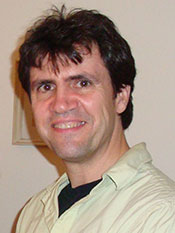Program Information
Recent Advances in Virtual Tools for Validation of 3D/4D Breast Imaging Systems (TG234)

K Myers
C Graff
P Bakic
M Das
A Avanaki
P Bakic
K Myers1*, C Graff2*, P Bakic3*, M Das4*, A Avanaki5*, (1) Office of Science and Engineering Laboratories,FDA, Silver Spring, MD, (2) FDA, Silver Spring, MD, (3) University of Pennsylvania, Philadelphia, PA, (4) University of Houston, Houston, TX, (5) BARCO, Beaverton, OR
Presentations
4:30 PM : Introduction - K Myers, Presenting Author4:40 PM : Development of a virtual breast phantom from a multi-modality perspective - C Graff, Presenting Author
4:55 PM : Simulation of breast anatomy at the cellular scale - P Bakic, Presenting Author
5:10 PM : DBT Applications of Feature-Adaptive Visual-Search Model Oberver - M Das, Presenting Author
5:25 PM : Towards a feature-based anthropomorphic model observer - A Avanaki, Presenting Author
5:40 PM : Panel Discussion - P Bakic, Presenting Author
MO-FG-209-0 (Monday, August 1, 2016) 4:30 PM - 6:00 PM Room: 209
This symposium will review recent advances in the simulation methods for evaluation of novel breast imaging systems – the subject of AAPM Task Group TG234. Our focus will be on the various approaches to development and validation of software anthropomorphic phantoms and their use in the statistical assessment of novel imaging systems using such phantoms along with computational models for the x-ray image formation process. Due to the dynamic development and complex design of modern medical imaging systems, the simulation of anatomical structures, image acquisition modalities, and the image perception and analysis offers substantial benefits of reduced cost, duration, and radiation exposure, as well as the known ground-truth and wide variability in simulated anatomies. For these reasons, Virtual Clinical Trials (VCTs) have been increasingly accepted as a viable tool for preclinical assessment of x-ray and other breast imaging methods. Activities of TG234 have encompassed the optimization of protocols for simulation studies, including phantom specifications, the simulated data representation, models of the imaging process, and statistical assessment of simulated images. The symposium will discuss the state-of-the-science of VCTs for novel breast imaging systems, emphasizing recent developments and future directions. Presentations will discuss virtual phantoms for inter-modality breast imaging performance comparisons, extension of the breast anatomy simulation to the cellular level, optimized integration of the simulated imaging chain, and the novel directions in the observer models design.
Learning Objectives:
1. Review novel results in developing and applying virtual phantoms for inter-modality breast imaging performance comparisons;
2. Discuss the efforts to extend the computer simulation of breast anatomy and pathology to the cellular level;
3. Summarize the state of the science in optimized integration of modules in the simulated imaging chain;
4. Compare novel directions in the design of observer models for task based validation of imaging systems.
Funding Support, Disclosures, and Conflict of Interest: PB: Research funding support from the NIH, NSF, and Komen for the Cure; NIH funded collaboration with Barco, Inc. and Hologic, Inc.; Consultant to Delaware State Univ. and NCCPM, UK. AA: Employed at Barco Healthcare.; P. Bakic, NIH: (NIGMS P20 #GM103446, NCI R01 #CA154444); M. Das, NIH Research grants
Handouts
- 115-31709-387514-119428.pdf (C Graff)
- 115-31710-387514-118693.pdf (P Bakic)
- 115-31712-387514-119429.pdf (A Avanaki)
- 115-34546-387514-118705.pdf (K Myers)
Contact Email:






